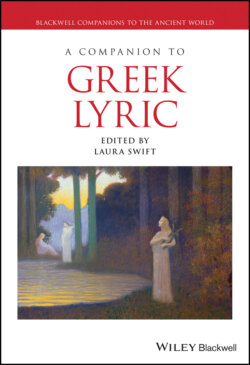Читать книгу A Companion to Greek Lyric - Группа авторов - Страница 13
The Great Masters of the Archaic and Early Classical Periods
ОглавлениеCountless traditional songs must have been sung and danced, and countless new song-dances must have been produced in the Greek cities over the centuries. Of this prolific output little has survived: names of great masters, titles of their songs, and a small number of their poems—mostly in fragments.
Probably all nine poets who were included in the Alexandrian canon of the nine lyric poets tried their hand at choral compositions. Alcman, who lived and composed in 7th-century cosmopolitan Sparta, became famous for his partheneia, choral compositions for female choruses (AP 9.184.9).11 In 1855 a papyrus found in a tomb in Saqqara by Auguste Mariette brought to light a precious song that Alcman composed for a Spartan female chorus. If we take into account the importance of female choruses in the religious and social life of the Greek polis, the surviving fragments are frustratingly few. I shall come back to song-dances for young women in the next section.
At the other side of the Aegean the most famous female poet of the ancient world, Sappho, probably composed songs for both solo and choral performances on Lesbos.12 In the next section I shall look at some evidence that depicts Sappho as a chorodidaskalos, i.e., chorus teacher/leader. The other famous Lesbian poet, Alcaeus, is mostly associated with compositions for the solo voice, but some scholars have suggested the possibility of compositions for choral performance in ritual contexts.13
According to the 10th-century ad dictionary Suda, Stesichorus was the first to set up a chorus to cithara-singing (Sud. Σ 1095 (iv 433 Adler)). This testimony together with the length of Stesichorus’ compositions gave rise to the view that Stesichorus was a citharode, but this view has been persuasively refuted.14 If the testimony claiming that Stesichorus was the first to set up a chorus has any authority, the reference must be to some Stesichorean choral innovation and its impact. In all likelihood he made his reputation leading his choruses first in Western Greek festivals and then in Spartan and Athenian festivals.15 Another Western Greek, Ibycus from Rhegium, also composed for choruses and drew his inspiration from Homer and the epic cycle.16 He spent time at the court of Polycrates on Samos and took part in the tyrant’s symposia which must have been the venue for his homoerotic songs, probably composed for a solo voice. Another famous poet associated with Polycrates was Anacreon from Teos. Anacreon is thought to have composed love songs for the symposium, but it is possible that some of his hymns were meant for choral execution. Moreover, it has been shown that he was perceived as a choral poet by the later Anacreontean tradition.17
Very few fragments survive of Simonides’ choral compositions, but as we shall see in the next section he became legendary for his fitness as a chorodidaskalos in his old age. The number of his victories in dithyrambic contests also became legendary: an epigram claims that he won fifty-six (XXVII Page). Some scholars have thought that this number too high, but it sounds right if we take into account the poet’s longevity and Panhellenic success.18
We are infinitely luckier with Pindar’s and Bacchylides’ choral compositions. Bacchylides’ poetry was essentially lost until a papyrus bought by E. A. Wallis Budge in Egypt reached the British Museum in 1896 and was edited by Kenyon a year later.19 In addition to epinicians, this papyrus preserved a number of dithyrambs, two in very good condition (c. 17 and 18). The best preserved corpus by far is Pindar’s epinicians. Some modern scholars have argued that epinicians were intended for solo performance. The scales have tipped in favor of chorality, a view that has ancient authority as well, but the heated controversy in the 1980s and the 1990s has shown that the texts alone can lead to diametrically opposing views.20 In any event our knowledge of Pindar’s prolific output and range shows that he composed mainly for choruses. We know that the Alexandrian edition of Pindar consisted of 17 books: 1 book of hymns, 1 book of paeans, 2 of dithyrambs, 2 of prosodia, 3 of partheneia, 2 of hyporchemes, 1 of encomia, 1 of threnoi, 4 books of epinicians.21
The distinction between choral and solo compositions is unquestionably important for the reconstruction of the occasion and the audio-spectacle, but their boundaries were fluid. We know that choral compositions were re-performed solo and that solo compositions re-performed chorally.22 There are also songs that conjure up different performance venues, such as sanctuaries and symposia, which indicate different performance modes.23 Moreover unforeseen circumstances and/or practical considerations might dictate a course of action at variance with the initial intention of a given composition.
